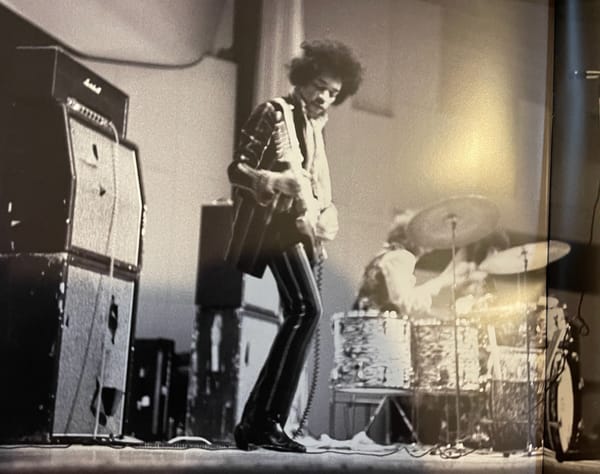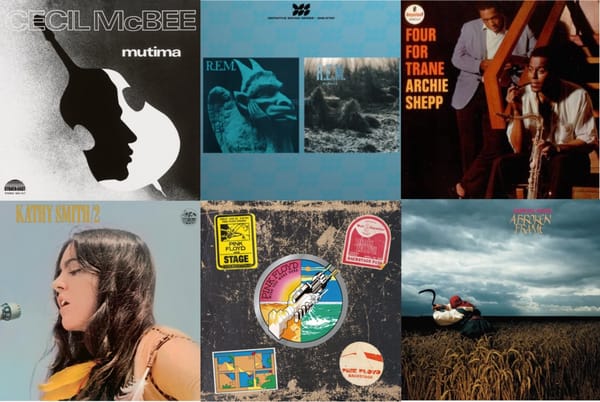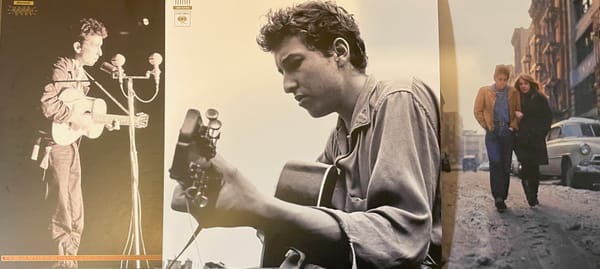Review: Double the vinyl pleasure with Buckingham Nicks
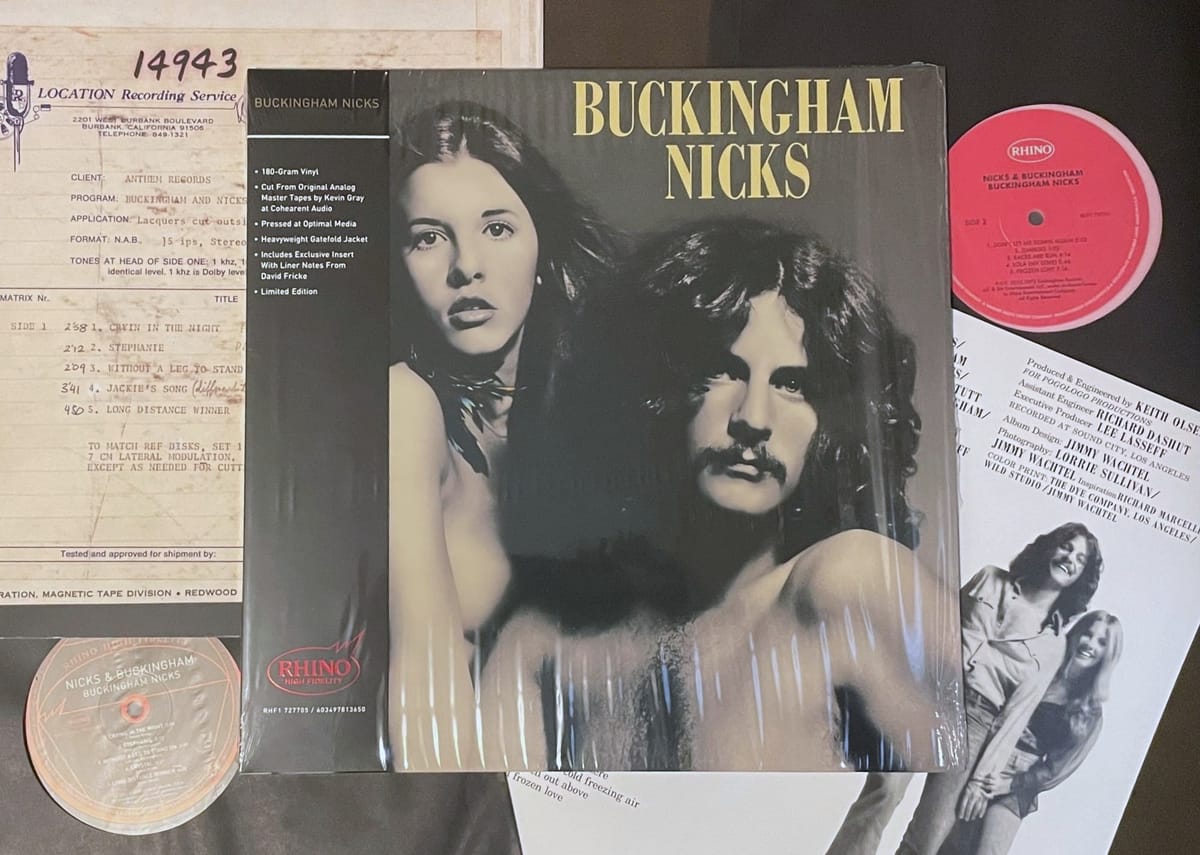
The duo’s pre-Fleetwood Mac album Buckingham Nicks is finally back on vinyl—in two all-analog versions.
Fleetwood Macologists more learned than me can determine the sequence of events that led to the new, long-awaited reissue of Buckingham Nicks, the 1973 album by Stevie Nicks and Lindsey Buckingham that directly led to the duo joining Fleetwood Mac. It arrives after a time when relations between the notoriously fractious pair were at their worst, after Nicks kicked Buckingham out of Fleetwood Mac in 2018 and remarks by both in recent interviews were at their most barbed. Obviously an agreement was made, and there are even rumors of the pair reuniting for a tour. (I’m not buying it.) But this is a vinyl newsletter, not a gossip rag, and the fact is this: We now have not one but two new versions of Buckingham Nicks—an album that has been out of print since the early ’80s—to play on our turntables.
The Rhino High Fidelity version is ostensibly the high-end choice; it’s an all-analog cut from Kevin Gray of Cohearent Audio, pressed at Germany’s Optimal Media and arriving in a Stoughton tip-on jacket with a four-page leaflet that includes liner notes and images of the tape boxes. At $40, it’s at a price point $15 higher than Rhino’s standard retail version, which comes in more or less a barebones replica of the original 1973 gatefold jacket, and in five different colors of vinyl: pink, blue, yellow, violet, and good ol’ black. Most of these variants were made at GZ Media’s Memphis Record Pressing, and it looks as though there are also European versions floating around that were manufactured at GZ’s Czech facility. Fascinatingly, this cheaper version is also all-analog, cut by Chris Bellman of Bernie Grundman Mastering, and in fact, Gray and Bellman used the same exact copy tape of the master. Gray got to run the tape first, if those things matter; Bellman went second and also made the digital masters for CD, streaming, and high-res download. (The master tape was not used—its whereabouts and condition have not been reported, to my knowledge.)
I listened to both new vinyl versions alongside a ’70s pressing of the album, and there’s just-plain-great news and there’s also-great-but-perhaps-surprising news. The just-plain-great news is this: There is no bad version of Buckingham Nicks on vinyl. They all sound exceptional: the Gray/RHF, the Bellman, and the original pressing. You’ll be happy with any version. As for the also-great-but-perhaps-surprising news? I’ll get there shortly.
The album itself is a wholly enjoyable California pop-rock record from the 1970s, a style that evolved out of ’60s West Coast folk rock and psychedelia, the sun-drenched voices of the Beach Boys, and the early ’70s singer/songwriter explosion. Buckingham’s acoustic guitars are layered en masse, and the duo’s harmonies enliven every song. There are even occasional rock fireworks, such as in the album’s grand finale, “Frozen Love.” It’s sort of understandable why the album wasn’t a huge hit, as it’s lacking that undeniably catchy, emotionally everlasting song that they would start churning out for Fleetwood Mac in short order. The album’s “Crystal” was remade on 1975’s Fleetwood Mac, but for my money the highlight of Buckingham Nicks is “Races Are Run,” a Nicks ballad that’s a precursor to the songs she’d soon write for what was about to become the biggest band of the late ’70s. There are other portents, too: Buckingham’s close-to-the-bridge Travis picking in “Lola (My Love)” would be revisited in “The Chain” on 1977’s Rumours, and the instrumental “Stephanie” (Nicks’s given name) sounds like a dry run for “Never Going Back Again.”
What’s less understandable is why the album has languished in the void for decades, especially seeing as how the music of Fleetwood Mac’s heyday has reached new generations, entering a new phase of popularity in the 21st century. Buckingham Nicks was obviously rushed back into print in 1977 once Rumours became the biggest thing going, and it more or less stayed on record store shelves until the early ’80s, but then it disappeared. Ever since, the only way to hear it was to score an increasingly expensive used copy or through possibly illicit digital means. Nicks famously hates the cover image, a topless photo taken against her will, so I imagine that’s part of it.
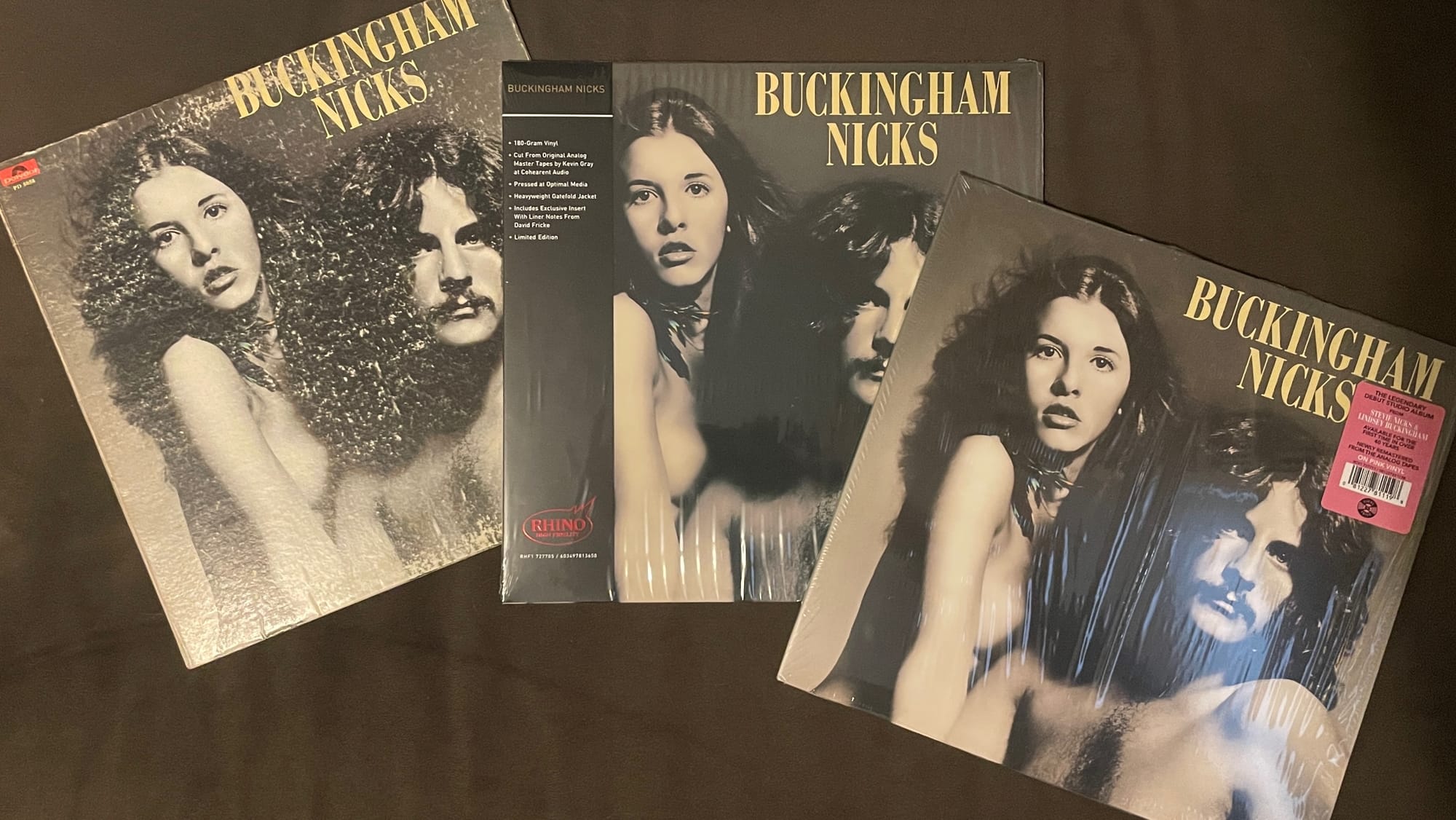
I’ll start with the ’70s pressing, as that is the standard by which the two new cuts should be measured. The copy I auditioned was mastered at Sterling Sound, but it does not appear to be the initial Robert Ludwig cut from 1973—his telltale initials are not found in the deadwax, and the runout contains “REPL,” matching this 1973 Monarch entry in Discogs, although the layout of the track list on the labels is very slightly different. In any case, the Monarch pressing sounds perfect. It has that warm, laidback, vintage ’70s sound, where the acoustic guitars are like a soft bed of pine needles for your ears and the drums have a bounce and snap without being too aggressive. In fact, it has that innate quality of the dozens (hundreds?) of other ’70s California rock records that would soon be recorded on Sound City’s famous Neve 8028 mixing console—as it turns out, Buckingham Nicks was the very first album to use it. The sound on the ’70s pressing has a freshness, roundness, and just-rightness that would be very difficult for the new pressings to beat.
The Kevin Gray mastering on my unnumbered Rhino High Fidelity pressing is significantly more forceful. Cut at a perceptibly high level, the tone of each instrument jumps out of the speakers and pushes its way into your ears. The soundstage is huge, extending to the full range of the audio field, but I occasionally experienced the sonic equivalent of looking at an IMAX screen from a seat that’s just a little too close. Buckingham’s acoustic guitars are more powerful-sounding, presented with full precision and depth but perhaps missing just a hint of the wonderful folk musicality on the original pressing. Its snaps and twangs are robust rather than homey, and the occasional chiming string leaps out and sounds piercing rather than bell-like.
In fact, my primary impression of the Gray cut is one of saturation, where all the ingredients are beefed up and some of the musical subtleties are magnified beyond perhaps their intended design. Rather than offering a three-dimensional mise en scène where different musical elements in the mix can come forward or recede, everything sounds pressed up against the glass. On busier-sounding tracks, like “Don’t Let Me Down Again,” the music required my full attention, as it would become slightly irritating as background noise if my focus wandered away. To use another metaphor, the Gray cut is a hop-forward double IPA, explosively flavorful and occasionally palate-numbing. Some people will undoubtedly prefer this presentation for its clarity and massive soundstage; while it definitely grew on me over multiple listens, at the end of the day it was my least favorite of the three pressings.
Which leaves the standard $25 Bellman cut (my copy is the pink vinyl variant with “Vinyl Voice” on the hype sticker, which I believe is connected to Alliance Distribution). And boy, is this a wonderful-sounding record. If it’s not the equal of the ’70s pressing, it’s darn close. The integration of the guitars, bass, drums, and voices in the soundstage is pleasing and intoxicating. From the opening strum of “Crying in the Night,” this album has a fully broken-in, comfortable sound, like a well-worn pair of jeans. The background keen of the slide guitar in “Stephanie”—I don’t know if that’s Buckingham or session guitarist Waddy Wachtel, but it sure sounds like Peter Green!—takes on an airy lift that’s just magical, and the closing instrumental section of “Lola (My Love)” has an easygoing jaunty quality, where you can almost see the sticks bouncing off the drum head. On “Frozen Love,” the more strident guitars and vocals are kept in check and never slide out of balance, and the gradual buildup into the proggy epic instrumental section is natural-sounding and full of suspense.
So that’s the also-great-but-perhaps-surprising news: Owners of the original cut don’t need to shell out for a new copy (unless they want to), and anyone finding the Gray/RHF cut out of their price range can actually take home a slightly nicer-sounding version at a lower price. Also, the everyday jacket that the Bellman version comes in is easier to deal with than the stiff Stoughton jacket of the RHF edition. Sadly, the liner notes are exclusive to the RHF version, which is a real shame, as David Fricke’s essay provides a lot of interesting info about the recording of the album and should be widespread across every new version available for purchase, including the CD. (One thing you will read about a lot in this newsletter is the vital importance of including good liner notes in a reissue.)
If this sounds like I’m being harsh on the Gray/RHF cut, that’s not the intent. I liked it plenty, just not as much as the ’70s pressing or the lovely new Bellman cut. The RHF does sound incredible. As I said, I think some will prefer it—Gray has built up an unexpected cult around his work, and his cuts are generally enormous-sounding and remarkably detailed. That can be a real thrill when listening to a small-ensemble jazz record recorded live in the room. When it comes to a densely layered, overdubbed multitrack recording like Buckingham Nicks, things can start to sound a little crowded for my tastes.
Still: How cool is it that the more widely available and affordable version of Buckingham Nicks sounds so good? Nobody who takes home a copy of the Bellman cut needs to feel like they’re missing out on an “ultimate” version that is out of their grasp. And since Fleetwood Mac has a huge fan base that extends far beyond the demographic of audiophiles and FOMOers that follow the Rhino High Fidelity series, that’s a very happy outcome.
Some quick notes about the quality of the pressings: Both were basically perfect with one small flaw each. There was a repeated ticking noise at the start of Side A of the RHF/Gray version that didn’t go away after ultrasonic cleaning; otherwise the disc was flat, silent, and defect-free. And the Bellman version, while on colored vinyl which is not my preference, had no audible defects but had a very tiny warp that did not affect play; it too was silent and audibly defect-free.
There’s another gripe that others have voiced, so it should be addressed. Some grew upset when Kevin Gray recently revealed on the ecoustics podcast that the tape he and Bellman used was not the master but a copy. They felt misled by Rhino High Fidelity’s marketing materials that ostensibly touted a fresh cut sourced directly from the master tape. While I agree transparency is crucial, I think this is sort of expected: Rhino has been using US copies of UK masters for this series regularly, such as in the case of Black Sabbath and the Sex Pistols. And it’s more than likely that the Buckingham Nicks master tape is not in the best condition after years of use. So Rhino should have been upfront about all of this, but I don’t think the end result is compromised at all.
While Rhino’s rollout of the two Buckingham Nicks reissues has been confusing, the end results are pretty spectacular. And there’s even this extra dividend for vinyl trainspotters with cash to waste: the ability to compare the Gray and Bellman cuts and see what two of the best vinyl masterers in the game right now can do with the same tape. It’s an opportunity to see what the comparison reveals about your system and your taste. For me, the Bellman cut was the clear winner—but regardless of what version of Buckingham Nicks you put on your table, it's bound to sound good.
Rhino High Fidelity 1-LP 33 RPM (analog source, copy tape to lathe, mastered by Kevin Gray) • black vinyl
Rhino 1-LP 33 RPM (analog source, copy tape to lathe, mastered by Chris Bellman) • pink vinyl (black, blue, yellow, and violet variants also exist)
Listening equipment
Table: Technics SL-1200MK2
Cart: Audio-Technica VM540ML
Amp: Luxman L-509X
Speakers: ADS L980

